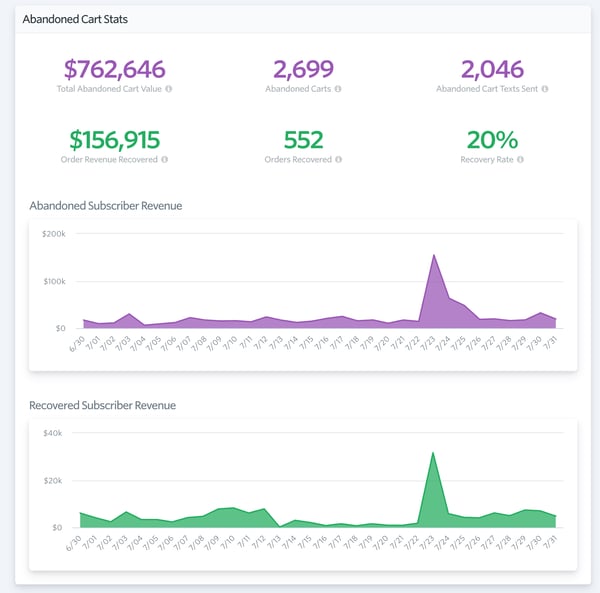March 2, 2020
 by Matt Baglia / March 2, 2020
by Matt Baglia / March 2, 2020

Text marketing campaigns are a great tool for businesses as they seek to connect with their audiences.
Because SMS marketing feels so personal, people tend to open most branded text messages and interact with them. In fact, statistics show text message marketing has an open rate of 98%. Plus, with text message marketing there are many ways to measure your success, which means you can tweak your SMS marketing campaigns until they’re highly maximized. Doing so, however, requires you to be specific about the SMS marketing metrics you measure.
We’ve compiled a list of ways to measure your next text marketing campaign to make sure you’re getting the most out of your efforts. Measuring the right elements of your text marketing strategy and responding to your results is the best way to ensure repeated success.
Even if you’ve had success with your past text marketing endeavors, it’s important to identify what works and what could be improved for any in the future. Since text message marketing offers you many different data points, understanding the return on investment for a text message marketing campaign is quite straightforward. Here’s how you can assess both the power of your text message marketing strategies and the impact on your bottom line.
When you send coupons in a text marketing campaign tracking the redemptions is an essential way to measure how effective your campaign was. Keep a record of how many coupons were sent out and how many were redeemed to create a percentage of coupon redemptions. When you launch your next campaign, you can use this percentage as a benchmark for success.
You might also want to track how soon coupons were redeemed after sending a text and try to assess whether changing the wording or adding more urgency with your expiration date increases the amount of redemptions.
Utilizing unique promo codes is a great way to track the success in this area. When choosing a promo code for your text marketing campaign, here’s what you’ll want to keep in mind:
Troubleshooting: Have you noticed your coupon redemptions are lower than you’d like? This could indicate your offer is not compelling enough, or you don’t have a clear call-to-action in your copy. Review these elements of your offer, as well as the timing of your text message, to decide what to tweak. However, you don’t want to offer something so valuable that the cost of fulfilling it actually hurts your revenue. That’s why you’ll need to measure average campaign order values to help inform the size of offer you should create.
If you’re putting time and energy into text marketing, the hope is that your efforts will see a positive impact on revenue. One key element of knowing how well you’re tracking when it comes to return on investment is assessing what you have recovered from abandoned carts.
One of the most difficult business problems for any online seller is figuring out how to reduce the amount of revenue lost from abandoned carts. Sending a text can be the difference between recovering and losing a sale, especially since a properly executed abandoned cart SMS strategy can recover up to 58% of abandoned carts. When measuring the impact of your SMS marketing strategy, be sure to look at the total amount of recovered revenue from abandoned cart text messages.
The graph below shows the amount recovered for one company over a 30-day period by sending automatic abandoned cart text messages. This metric should be assessed at least monthly and definitely quarterly when determining the value of your SMS marketing initiatives.

Not only does measuring how much you’ve earned from sending abandoned cart messages show whether or not you need to tweak your copy, but it also shows you just how valuable your text marketing is for the overall return on investment.
Click-through rates are a great key performance metric for your text marketing campaign. It shows not just how many people actually opened your message, but how many of those who opened followed your call to action.
When you’re measuring click throughs you can measure total clicks or unique clicks. Measuring total clicks will show you how many times the link was clicked overall – this measurement doesn’t distinguish if one person clicked on the link 100 times, or if 100 different people clicked on the link.
To get more specific, measure unique clicks. This will show you how many individuals followed your call to action and clicked through.
By knowing how much a typical customer spends with you after you’ve run an average text campaign for your company, you’ll start to get an idea of the value of each subscriber on your text list. One value that might be helpful in determining the return on investment of your text marketing campaign is to measure the size of your list and the value each added subscriber represents for your business.
In order to track the value of your list in that way, you’ll have to measure two metrics in tandem: new subscribers and churn rate. If you’ve never heard of churn rate, it’s basically a measurement of the people who unsubscribe from your texting list. While losing contacts is nearly inevitable when reaching out to consumers via text, keeping track of opt-out rates can help you gauge the success of a given campaign.
For a typical text campaign, the opt-out rate tends to fall anywhere from 0.5% to 6%, depending on how engaged your text list is.
In the day following a text campaign, a 24-hour trailing opt-out rate allows you to see the number of people who have unsubscribed from your text list. A big opt-out rate could mean that the offers you’re providing your consumers aren’t valuable or actionable enough. If you fail to use your text characters to give your audience offers they’re excited about, they might choose to leave the list.
At the same time, you’ll also want to keep track of new subscribers and make sure this rate is outpacing your opt-out rate.
You don’t want to stop just at measuring click through rates, but go a layer deeper to understand how many people who click on a link converted into paying customers.
Using UTM parameters you can measure this within Google Analytics after a customer has clicked on a link. You can and should measure how much they spent after clicking through. This will give you an idea of the average campaign value for each text marketing campaign that you run, which is crucial to determining the return on investment of your text marketing strategy.
By comparing your conversion rate to your click through rate you can determine how well your landing page is converting or if you need to make adjustments to this portion of your text message marketing strategy. The landing page people arrive at after click through a text message is just as important as the content of the text message itself.
As you become more advanced in text message marketing, there are other in-depth measurements you can use to help determine areas of weakness in your strategy and fortify them with new initiatives or techniques.
Even though text message marketing is an excellent way to reach customers and create loyalty, it also works best when you’re consistently reviewing your own performance to discover how you can earn a better return on your investment.
Since SMS marketing analytics are so readily available, it represents an exciting opportunity to test and measure in real time, which can help you implement tweak and changes to your strategy that can profoundly impact your return on investment.
Matt Baglia is the Co-Founder and CEO of SlickText, a text marketing platform that provides mobile communication solutions for organizations of all sizes.
Are you using data to drive your sales strategy?
 by Matej Kukucka
by Matej Kukucka
The buyer's journey consists of awareness, consideration, and decision. That final conversion...
 by Daniella Alscher
by Daniella Alscher
Product launches. Webinars. Co-marketing campaigns. Email newsletters. None of these marketing...
 by Lauren Pope
by Lauren Pope
Are you using data to drive your sales strategy?
 by Matej Kukucka
by Matej Kukucka
The buyer's journey consists of awareness, consideration, and decision. That final conversion...
 by Daniella Alscher
by Daniella Alscher

